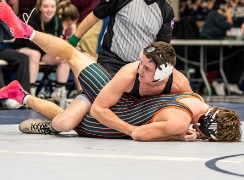Just part of the game
I’m all for keeping athletes safe, regardless of age or sport.
My views on so many of the newer high school and college football safety rules are well documented. I am not a fan of many of the rules designed with player safety in mind (read the continuing slant of the game in favor of offense) but I understand the need for player safety.
I do not want to see kids get hurt but I worry we have gone overboard with knee jerk reactions to injuries. Let’s face it: Injuries are going to happen no matter how safety rules are in place. Injuries are part of the game.
Which game?
Take your pick.
As I’ve written many times, I grew up in a different era.
I still think it should be legal to tackle a ball carrier by his hair — if there is that much hair outside the helmet a defender should be allowed to play Tarzan with it.
You’re there to play football, not make a fashion statement — ponytail or five extra yards, your call buttercup.
Such decisions are not left to me and it’s probably a good thing. If I controlled the rules of high school and college sports I’m confident those who really do not want to play the game would be effectively weeded out.
A tackle should hurt. A block should hurt. It should be a painful reminder not to let the other guy do it again. Some might call that negative reinforcement — I call it motivation.
Every player should know what it feels like to walk off the field in a dirty uniform, soaked in his own sweat, battling muscle cramps, and tasting his own blood.
It’s called leaving it all on the field, be it in practice or a game.
I know — the ravings of a crazy old man.
Such rules don’t just apply to football.
In baseball, we weren’t guaranteed a number of at bats. Chances to hit were determined by how well the rest of your team hit. If they kept hitting, you kept batting, especially in sandlot games.
Sandlot games were the best.
Most of those games were ended due to only three things — darkness, supper, or a fistfight (or series of fistfights depending on the teams involved).
No mercy rule or umpires were needed.
In 1977, we didn’t know losing by 12 runs would damage our self-esteem and cause us to grow up wanting to climb on top of a post office and shoot spitwads at people. Most of the boys I grew up with already had that aspiration before they picked up a baseball glove.
Pitch counts? Who needed a pitch count? If you couldn’t get people out, you didn’t pitch.
For decades kids threw more than a 100 pitches in one sandlot game and no one’s fell off, the mound did not explode, and half of the team didn’t need counseling and Tommy John surgery.
If you got shelled, you came back the next day and pitched angry because you had something to prove.
It was the same in the field. If a kid couldn’t field, it wasn’t uncommon to hear the phrase, “Hit it to [insert name here]” as in “Hit it to Cecil, he can’t catch.” More often than not, the kid who couldn’t field eventually became a pretty good fielder — even Cecil.
Of course these were sandlot (or pickup games) and no one was keeping stats. The focus was on winning.
We didn’t need uniforms, a schedule, a fundraising project, a coaching staff, or a series of rules guarding our physical and psychological wellbeing.
We didn’t need to travel all over the state and region to play. It was just a game and it was fun.
We survived and a few even thrived in that environment.
At the end of the day, that is the purpose and spirit of the game.
Which game?
Take your pick.

